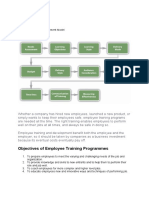Training: Place of Training in Company Management
Training: Place of Training in Company Management
Uploaded by
ThariqAhammedCopyright:
Available Formats
Training: Place of Training in Company Management
Training: Place of Training in Company Management
Uploaded by
ThariqAhammedOriginal Description:
Original Title
Copyright
Available Formats
Share this document
Did you find this document useful?
Is this content inappropriate?
Copyright:
Available Formats
Training: Place of Training in Company Management
Training: Place of Training in Company Management
Uploaded by
ThariqAhammedCopyright:
Available Formats
TRAINING
Give a man a fish he will eat it. Train a man to fish he will feed his family
This is a saying which highlights the importance of training man. Employee
training is the process whereby people learn the skills knowledge attitudes and
behaviours needed in order to perform their job effectively. No big industrial
organization can know ignore the training and development needs to its employees
without seriously inhabiting its performance even the most careful selection dose
not eliminate the need for training since people are not molded to specifications
and rarely meet the demands of their job adequately
Training is the act increasing the knowledge and skill of an employee for
doing a particular job .it is concerned with imparting specific skill for particular
purpose.
PLACE OF TRAINING IN COMPANY MANAGEMENT
Some organizations regard training as unnecessary. They think that cost of
training is high and not worth it. In these organization training is accorded allow
status and is treated as a peripheral activity. The budget for training is also kept
very low. Trainees are selected causally and at random without any objective
standards. Training opportunities are doled out to employees as a reward for their
good behavior for or long service or to get relief for some time from a trouble
making employee. This policy lowers employee morale and fails to produce and
good result. Another variant of this policy are those organizations were training is
treated nearly as a show piece to look modern. In this organizations training is
more decorative than functional.
Some organizations treat training as a device to overcome certain specific
problems. Here training accepted as desirable when clear cut need is identified.
Typically the training in this case is a course with a definite limited objective once
given and the effort is discontinued. Finally there are some organizations which
regard training as a continuous activity. These organizations believe that training is
a permanent relationship which exists between the superior and the subordinates so
that every superior in the organization (and not only the personal manager) is
responsible for training which always goes on. Day in and out as some learning
inevitably takes place when workers watch their superior doing a job behaving in a
particular manner.
NEED AND OBJECTIVES OF THE TRAINING
The need of training in part depends upon the companys selection and
promotion policies companies that attempt to employ only people who already
have the needed skills. Place less emphasis on training on the other hand firms that
stress promotion from within may have to take special steps to ensure that
employees develop the skills which will be needed
Surveys indicate that nearly all larger organizations employee some formalized
training. The major objectives of the training are as follows:
1. To train the employee in the company culture pattern.
2. To train the employee to increase his quantity and quality of output. This
may involve improvement in work method or skills.
3. To train the employee for promotion to higher jobs.
4. To train the employee to avoid social mistakes.
5. To train the employee toward better job adjustment and high morale.
6. To reduce supervision wastage and accident. Of effective work habit and
method of work should contribute toward reduction in the accident rate. Less
supervision and wastage of material.
DETERMINING THE TRAINING NEEDS
In order to determine the training needs of an organization the personal
manager should seek information on the following points.
a. Whether training is needed?
b. Where training is needed?
c. Which training is needed?
SELECTION OF TRAINING
Although it is true that in selecting persons for training a company generally
gives primary consideration to its own benefits and secondary consideration to the
benefits acquiring to the individual yet the standards used for selecting training
programmers participants should be carefully devised and communicated widely
throughout the organization. Training opportunities should not be passed out as a
reward for a good behavior or for long service or to get relief for some time from a
trouble making employee. Fairness in applying the standard is required and can
help boost employee morale.
Programmers having high selection standards became high status prestige
programmers which challenge the best person in the organization to make the
grade. Training a person who has no ability and willingness to learn is likes
sensing as ass to college. All one can hope to get back is an educated mole.
Whenever an individual is sponsored for training he should be told
categorically the reasons for sponsoring him and the expectation of the
organization from him after him return from the programmed. Most companies do
not inform the employees why they have been sponsored such practice reduce
learning as the employees sponsored are more concerned about the reasons for
being sponsored than actually getting involved in and benefiting from the training.
TECHNIQUES OF TRAINING
Training methods are generally classified by the location of instruction,
Training can take place in various situations on the job or off the job in the
company or outside the company it necessary involves the use of a number of tools
methods and techniques. Some of the widely used training methods are as follows.
1. ON THE JOB TRAINING
The most important type of training is training - on the job. The
experience of actually doing something makes a lasting impression and has a
reality that other type of training cannot provide. The worker in this method
teaches the master the operations involved on the actual job situation under the
supervision of his immediate boss. Some important advantages of this type of
training are as follows:
(A) It can be learned in a relatively short period of time say a week or two.
(B) No elaborate programmed is necessary as far as subject content is
concerned.
(C) There is no line staff conflict because the workers own supervisor is the
instructor.
(D) It is highly economical.
(E) It is not located in an artificial situation either physically or psychologically
and therefore eliminates the possible problem of transfer of learning.
For training on the job to be effective the personal manager must take
time to se really occurs in other word it is necessary to make sure that the
supervisor who is imparting training is trained and motivated to be good trainer. If
be views this training as burdensome and nuisance it will produce no good effect.
A training method of carrying out on the- job training which has been
found to be of great value is known as the training within industry (TWI) or the
capsule method The method was devised in the united states during the second
world war when a large number of people had to be training in a short period.
There are several type of training programmers which make use of on the- job
training programmers. There are several type of on the job training. They are as
follows.
(1) JOB INSTRUCTION TRAINING (JIT)
Commonly known as JIT this technique of training was developed World
War II. It is a four step instructional process they are.
The trainee receives an overview of the its purpose and desired outcomes
with a clear focus on the relevance of training.
The trainers demonstrate the job in order to give the employee a model to
copy. The trainer demonstrates to him the right way to doing the job.
Traince is then asked to copy /the trainers demonstration. The
demonstrations by the trainer and repeated till the trainees master the right
way to perform the job.
Finally the employee does the job independently without supervision.
(2) Coaching
On the coaching by the supervisor is on important and potentially effective
approach. It is a kind of daily training and feedback given to employees by their
immediate supervisors. It involves continuous process of learning by doing
coaching involves personal instructions and guidance usually with extensive
demonstration and continues critical appraisal and correction. It has the advantages
of increased motivation for the training and minimization of the problem of
transfer from theory practice.
(3) Mentoring
It is somewhat different form of training method. In mentoring senior person
in the organization assumes the responsibility for training as well as grooming of a
junior person. A mentor as a teacher, guide, counselor. Philosopher, exemplar,
supporter and facilitator of the junior person.
(4) Position Rotation
It is the boarding of the background of the trainee in the organization. This
method involves the employee being sent through different jobs thereby providing
him a wider exposure.
(5) Apprenticeship
Apprenticeship training may be traced back to medieval times when
those who wanted to learn trade skill used to bind themselves to master craftsman
to learn by doing the work under his guidance.
(6) Committee Assignment
In this method the trainers are asked to perform special assignments and to
solve actual organizational problems. They also understand the personalities issues
and processes governing the organization.
2. OFF THE JOB TRAINING
In off the job training methods the trainees have to leave their work place
and devote their entire time to the training. A few off the job training methods
are as follows:
(1) Vestibule school
When the amount of on the job training that has to be done exceed the
capacity of the line supervisor a portion of this training is taken away from the line
and assigned to staff through a vestibule school. The responsibility to operate a
vestibule school generally rest with the personal department.
This training gets its name from the resemblance of the school to a vestibule
through which one passes before entering the main room if a house. Vestibule
training has the advantages of training large number of person without hampering
on going operation. It also saves costly machines from being damaged by
mishandling of the untrained workers. Moreover the trainee avoids the confusion
and treasure of the work situation and thus is able to concentrate on learning. The
only disadvantages of this type of training are that it is somewhat artificial and
there is generally a line staff conflict.
(2) Apprenticeship
This training disused in those trades crafts and technical fields in which
proficiency can be accrued after a relatively longer period of time in direct
association with the work and under the direct supervision of expert. In Indian
section 40 of the Apprenticeship Act 1961 Provides that no person can be engaged
as an apprenticeship to undergo apprenticeship training in a designated trade unless
such person or if he is a minor his guardian has entered into a contract of
apprenticeship with the employer and the contract of apprenticeship has been
registered with the apprenticeship advisor.
(3) Classroom Training
The classroom training is the traditional way of education which places the trainee
in a class room. Class room training takes place either inside the organization or at
some external selected sites may be institutes universities or professional
associations which have no connection with the company.
(4) Internship Training
This refers to a joint programme of training in which school and business co
operate to enable the students to gain a good balance between theory and
practice. Classroom principles are better understood against the practical
background in a factory.
3. Electronic Training
(1) Audio Visuals
(2) Computer based training.
(3) Electronic performance support system [EPSS]
(4) Distance and internet based training.
You might also like
- Training and Development in InfosysDocument34 pagesTraining and Development in Infosyskrupamayekar93% (14)
- Assignment On Training & DevelopmentDocument18 pagesAssignment On Training & DevelopmentNahidul Islam83% (18)
- Train the Trainer: Unlock your potential as a professional trainerFrom EverandTrain the Trainer: Unlock your potential as a professional trainerNo ratings yet
- H.R Final Exam AASTDocument10 pagesH.R Final Exam AASTA.Rahman SalahNo ratings yet
- Training & Development-1Document30 pagesTraining & Development-1Vishal Kumar RaiNo ratings yet
- Study On Training and Development in INFOSYSDocument34 pagesStudy On Training and Development in INFOSYSPrateek Maratha100% (1)
- 1.1 About The TrainingDocument48 pages1.1 About The Trainingindu priyaNo ratings yet
- CHAPTER ONE To Five Business Admin HNDDocument11 pagesCHAPTER ONE To Five Business Admin HNDdawhiteloadedNo ratings yet
- Effect of TrainingDocument45 pagesEffect of Trainingindu priyaNo ratings yet
- Unit 3 HRMDocument60 pagesUnit 3 HRMlakshayNo ratings yet
- Bhawna Singh FileDocument72 pagesBhawna Singh FileMayankRohillaNo ratings yet
- BMS Unit 3Document19 pagesBMS Unit 3Smitha KadiyalaNo ratings yet
- Traing and DevelopmentDocument10 pagesTraing and DevelopmentBini MathewNo ratings yet
- Unit-3 HRMDocument7 pagesUnit-3 HRM3 B 440 YuvankarthikeyanNo ratings yet
- T & D NotesDocument20 pagesT & D NotesAjay PhalkeNo ratings yet
- Importance of Training and DevelopmentDocument4 pagesImportance of Training and DevelopmentAnnaIzzatNo ratings yet
- Traning and DevelopmentDocument13 pagesTraning and DevelopmentSumaira khan100% (1)
- Training and Development: Trainig ProgrammeDocument109 pagesTraining and Development: Trainig ProgrammeAdarsh UdayanNo ratings yet
- International Training and DevelopmentDocument30 pagesInternational Training and Developmentreduan hasanNo ratings yet
- Define Traing AssignmentDocument10 pagesDefine Traing Assignmenttanveeralam9538No ratings yet
- Traning and DevelopmentDocument18 pagesTraning and Developmentdeep.dj3103No ratings yet
- BHRM Unit 3Document13 pagesBHRM Unit 3armish24uk11No ratings yet
- Training and Development Notes Unit 2Document16 pagesTraining and Development Notes Unit 2Prabhat ThakurNo ratings yet
- Makalah Manstrat SDMDocument21 pagesMakalah Manstrat SDMAfiqNo ratings yet
- Training and DevelopmentDocument36 pagesTraining and DevelopmentManishaNo ratings yet
- Objectives of Employee Training ProgrammesDocument13 pagesObjectives of Employee Training ProgrammesUtkarsh PrabhuNo ratings yet
- Retail TrainingDocument41 pagesRetail Trainingvikastiwari84No ratings yet
- Training and DevelopmentDocument12 pagesTraining and DevelopmentFawad Ali shaikh100% (1)
- Leson 3Document28 pagesLeson 3ladosehrawatNo ratings yet
- Employee Training: DefinitionsDocument19 pagesEmployee Training: DefinitionsHari NaghuNo ratings yet
- TOPIC 5-Training and Development of EmployeesDocument11 pagesTOPIC 5-Training and Development of Employeesarrowphoto10943438andrewNo ratings yet
- ganesh babu projectDocument34 pagesganesh babu projectSowmiyaaNo ratings yet
- Training: Difference Between Training and DevelopmentDocument5 pagesTraining: Difference Between Training and DevelopmentUpadhayayAnkurNo ratings yet
- Training & Development Short NoteDocument13 pagesTraining & Development Short NoteloharsudhakarNo ratings yet
- HRM Tranning and DevlopmentDocument3 pagesHRM Tranning and Devlopmentkhurram. khurshidNo ratings yet
- Training & DevelopmentDocument5 pagesTraining & DevelopmentVigram SenthilkumarNo ratings yet
- 4Th Module T & DDocument21 pages4Th Module T & DLOOPY GAMINGNo ratings yet
- 4182.training Methods and TechniquesDocument28 pages4182.training Methods and TechniquesAbhienav MishraNo ratings yet
- Ch. 5. HRMDocument13 pagesCh. 5. HRMneway gobachewNo ratings yet
- HRM ProjectDocument26 pagesHRM Projectguptasoniya247No ratings yet
- Training and DevelopmentDocument20 pagesTraining and DevelopmentSara taskeenaNo ratings yet
- Training and Executive DevelopmentDocument22 pagesTraining and Executive DevelopmentEldeen EscuadroNo ratings yet
- Siva ProjectDocument83 pagesSiva ProjectSowmiyaaNo ratings yet
- Impotance of TrainingDocument25 pagesImpotance of TrainingDANIEL CHEKOL100% (1)
- Training and DevelopmentDocument15 pagesTraining and DevelopmentmesoNo ratings yet
- Importance of TrainingDocument4 pagesImportance of Trainingraazoo19No ratings yet
- TRAININGDocument10 pagesTRAINING2105729No ratings yet
- BBCT 3023 Asgmt 2Document16 pagesBBCT 3023 Asgmt 2Ammd noorNo ratings yet
- T & D Notes Unit-IIDocument10 pagesT & D Notes Unit-IIrohanmodgil71No ratings yet
- Training and DevelopmentDocument44 pagesTraining and DevelopmentNemoNo ratings yet
- An HRM Presentation On Training & DevelopmentDocument32 pagesAn HRM Presentation On Training & Developmentrohitpatil222100% (1)
- AAST HR FinalDocument9 pagesAAST HR Finala7med3abdeenNo ratings yet
- Training and Development MBADocument27 pagesTraining and Development MBANikhil ChauhanNo ratings yet
- Research Methodology Company Profile 4) Data Analysis 5) Findings 6) RecommendationDocument70 pagesResearch Methodology Company Profile 4) Data Analysis 5) Findings 6) RecommendationJohnNo ratings yet
- Training and DevelopmentDocument16 pagesTraining and Developmenthome scienceNo ratings yet
- Zabihullah - 22149 (Training and Development Assignment)Document16 pagesZabihullah - 22149 (Training and Development Assignment)zabi ullah MohammadiNo ratings yet
- 10 - Training and DevelopmentDocument18 pages10 - Training and DevelopmentRamesh KumarNo ratings yet
- Project On Training & Development in HBLDocument61 pagesProject On Training & Development in HBLPinnam MallikarjunaNo ratings yet
- Assignment On The Job TrainingDocument7 pagesAssignment On The Job TrainingsunilbabaNo ratings yet
- Coaching Skills for Managers: The No Waffle Guide To Getting The Best From Your TeamFrom EverandCoaching Skills for Managers: The No Waffle Guide To Getting The Best From Your TeamRating: 5 out of 5 stars5/5 (2)
- PPT, SBM Assessment ToolDocument69 pagesPPT, SBM Assessment ToolMay Ann Guinto90% (20)
- Teachers Book Chapter4Document14 pagesTeachers Book Chapter4thandothemane253No ratings yet
- Training & DevelopmentDocument48 pagesTraining & DevelopmentAravindhan RanganathanNo ratings yet
- AP-Poultry Mod 1Document31 pagesAP-Poultry Mod 1Amera Mediodia Almaiz AlberastineNo ratings yet
- Software Testing Classes in PuneDocument4 pagesSoftware Testing Classes in PuneStad SolutionsNo ratings yet
- Lunenburg, Fred C Creating A Professional Learning Community NFEASJ V27 N4 2010Document7 pagesLunenburg, Fred C Creating A Professional Learning Community NFEASJ V27 N4 2010Guyan GordonNo ratings yet
- ISM A Framework For Curriculum, Pedagogy and Assessment KS3 Music WEBDocument13 pagesISM A Framework For Curriculum, Pedagogy and Assessment KS3 Music WEBSuresh KumarNo ratings yet
- PDEV 111 Answer 2nd QuarterDocument30 pagesPDEV 111 Answer 2nd QuarterChan-Chan Matamorosa50% (2)
- Phase 4 TesolDocument20 pagesPhase 4 Tesolakshita ramdasNo ratings yet
- Ypa Program InformationDocument2 pagesYpa Program Informationapi-535457890No ratings yet
- Chris Poole ResumeDocument2 pagesChris Poole Resumeapi-454347276No ratings yet
- CorrectionDocument5 pagesCorrectionVictor UsieNo ratings yet
- Cognitive Learning StyleDocument3 pagesCognitive Learning StyleDeepaPandeyNo ratings yet
- Curriculum - Vitae: Abhishek Kumar SoniDocument2 pagesCurriculum - Vitae: Abhishek Kumar SonisatnaNo ratings yet
- BUS 607 - Syllabus - Lepak & Gowan (4th Ed.)Document26 pagesBUS 607 - Syllabus - Lepak & Gowan (4th Ed.)Akansha dwivediNo ratings yet
- Moral Learning Shaun Nichols: Rational Rules: Towards A Theory ofDocument64 pagesMoral Learning Shaun Nichols: Rational Rules: Towards A Theory ofgosaiondryNo ratings yet
- Grade 9 WHLP MathDocument6 pagesGrade 9 WHLP MathAngela Paynante100% (2)
- Week 9 My InterlanguageDocument10 pagesWeek 9 My InterlanguageN SNo ratings yet
- Contents of Elementary Science in A Spiral ProgressionDocument11 pagesContents of Elementary Science in A Spiral ProgressionHepshebah De Dios SantuyoNo ratings yet
- Part 4 Values EducationDocument5 pagesPart 4 Values EducationGiero CalderonNo ratings yet
- DLP Entrep2 Dec 9-12, 2019Document2 pagesDLP Entrep2 Dec 9-12, 2019Marlon Caca100% (1)
- Melc Cpar Q1Document4 pagesMelc Cpar Q1Andrew Benedict Pardillo100% (3)
- Week 1 Foundations of Effective ReadingDocument10 pagesWeek 1 Foundations of Effective ReadingMa Marisa AyohanNo ratings yet
- CBE Review - EL Teaching Multi-Grade ClassesDocument29 pagesCBE Review - EL Teaching Multi-Grade ClassesErica Mondero Dizon100% (1)
- Working & Learning in Multiprofessional TeamDocument13 pagesWorking & Learning in Multiprofessional Teamnico nicoNo ratings yet
- Characteristics of LightDocument11 pagesCharacteristics of LightMark Gerald DalanonNo ratings yet
- Kylie Edwardson: EducationDocument3 pagesKylie Edwardson: Educationapi-508122087No ratings yet
- Syllabus-in-Management-ScienceDocument11 pagesSyllabus-in-Management-ScienceehlaandresNo ratings yet
- Prof Ed 6 DLP - 1.3 ObeDocument9 pagesProf Ed 6 DLP - 1.3 ObeRujhon Nabablit BahallaNo ratings yet
- Esld Course Outline Working 2Document3 pagesEsld Course Outline Working 2api-243678431No ratings yet

























































































